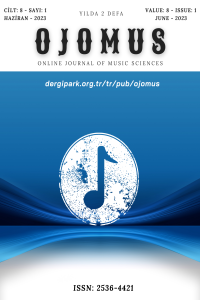GÜZEL SANATLAR LİSELERİNDEKİ KEMAN ÖĞRETMENLERİNİN UZAKTAN EĞİTİM SÜRECİNDEN ETKİLENME DURUMLARI
Bu araştırmada, Güzel Sanatlar Liselerindeki keman öğretmenlerinin uzaktan eğitim sürecinden etkilenme durumları incelenmiştir. Araştırmanın örneklemini basit tesadüfi yöntem ile seçilen 20 farklı Güzel Sanatlar Lisesinde görev yapan ve araştırmaya katılmayı kabul eden 43 öğretmen oluşturmaktadır.Araştırmada veri toplama aracı olarak araştırmacı tarafından özgün bir şekilde hazırlanmış anket formu kullanılmıştır. Anket formları Google Formlar aracılığıyla internet ağı üzerinden katılımcılara gönderilmiştir. Elde edilen veriler ise SPSS programı ile yüzde frekans analizi yapılarak çözümlenmiş, yorumlanmış ve önerilerde bulunulmuştur.Uzaktan keman eğitiminde öğretmenlerin büyük çoğunluğunun internet kaynaklı problemlerden olan ses- görüntü gecikmesi ve/veya donmasından bahsettikleri, özellikle başlangıç düzeyindeki öğrencilerin keman tutuş-duruş, sağ ve sol el postürleri konusunda zorluk çektikleri anlaşılmıştır. Ayrıca katılımcıların büyük çoğunluğunun ders süresini yetersiz bulması da dikkat çekmektedir. Katılımcıların çoğunluğu ev ortamının çalgı dersi için uygun olmadığı ve uzaktan eğitimin ise yüz yüze eğitim kadar faydalı olmadığı görüşündedir.
Anahtar Kelimeler:
Uzaktan eğitim, müzik, çalgı eğitimi, keman, güzel sanatlar liseleri
THE SITUATION OF VIOLIN TEACHERS IN FINE ARTS HIGH SCHOOLS IMPACTED BY THE DISTANCE EDUCATION PROCESS
In this research, the effects of violin teachers in Fine Arts High Schools from the distance education process were examined. The sample of the research consists of 43 teachers who accepted to participate in the research in 20 Fine Arts High Schools selected by simple random method.A questionnaire form, which was originally prepared by the researcher himself, was used as a data collection tool in the study. Questionnaire forms were sent to the participants via the internet via Google Forms and the obtained data were analyzed, interpreted and suggestions were made by performing percentage frequency and chi-square analysis with the SPSS program.It has been understood that the majority of teachers in distance violin education talked about audio-video delay and/or freezing, which are problems originating from the internet, and that especially beginner students have difficulties in violin holding-stance, right and left hand postures. It is also noteworthy that the majority of the participants found the course time insufficient. The majority of the participants are of the opinion that the home environment is not suitable for instrument lessons and distance education is not as beneficial as face-to-face education.
Keywords:
fine arts high schools, Distance education, music, instrument education, violin,
___
- Alberich-Artal, E. ve Sangrà A. (2012). Virtual virtuosos: a case study in learning music in virtual learning environments in Spain. European Journal of Open, Distance and E-Learning. Retrieved 11.03.2016 from http://www.eurodl.org/?p=current&sp=full&article=477
- Arıkan, R. (2018). Anket Yöntemi Üzerinde Bir Değerlendirme. Haliç Üniversitesi Sosyal Bilimler Dergisi,1(1),97-159. https://Dergipark.Org.Tr/Tr/Pub/Husbd/İssue/39647/452737
- Brändström, S, Wıklund, C. Ve Lundström, E. (2012). “Developing Distance Music Education İn Arctic Scandinavia: Electric Guitar Teaching And Master Classes”, Music Education Research, (14) 4, 448-456. https://doi.org/10.1080/14613808.2012.703173
- Creswell, J. W. (2003). Research design: Qualitative, quantitative, and mixed methods approaches (2nd ed.). Thousand Oaks, CA: Sage.
- Davies, P. (2000). Contributions from Qualitative Research. In H. T. Davies, M. N. Sandra, & P. Smith (Eds). What works? Evidence-based Policy and Practice in Public Services, 291- 316, Bristol, UK: Policy Press.
- Johnson, R.B. and Onwuegbuzie, A.J. (2004) Mixed Methods Research: A Research Paradigm Whose Time Has Come. Educational Researcher, 33, 14-26. http://dx.doi.org/10.3102/0013189X033007014
- Maki J. (2001). “Is It Possible To Teach Music in a Classroom from a Distance of 1000 km? Learning Environment of Music Education Using ISDN-Videoconferencing”, 2001 World Conference on Educational Multimedia, Hypermedia & Telecommunications. https://www.learntechlib.org/primary/p/8692/
- Maxwell, J. A. (2016). Expanding the history and range of mixed methods research. Journal of Mixed Methods Research, 10(1) 12–27
- Milli Eğitim Bakanlığı Orta Öğretim Genel Müdürlüğü (2016). Güzel Sanatlar Lisesi Çalgı Eğitimi Keman Dersi Öğretim Programı 9,10,11,12. Sınıflar, Ankara:Devlet Kitapları Müdürlüğü.
- Tashakkori, A., & Teddlie, C. (1998). Mixed methodology: Combining qualitative and quantitative approaches. Applied Social Research Methods Series (Vol.46). Thousand Oaks, CA: Sage.
- Uçan A. ve Günay E. (1980). Çevreden Evrene Keman Eğitimi. Ankara: Önder Matbaası.
- Şendurur, Y. (2001). Keman Eğitiminde Etkili Öğrenme - Öğretme Yöntemleri. G.Ü. Gazi Eğitim Fakültesi Dergisi Cilt 21, Sayı 3 (2001) 145-155. https://arastirmax.com/en/system/files/dergiler/5672/makaleler/21/3/arastirmax-keman-egitiminde-etkili-ogrenme-ogretme-yontemleri.pdf
- ISSN: 2536-4421
- Yayın Aralığı: Yılda 2 Sayı
- Başlangıç: 2016
- Yayıncı: Nilgün SAZAK
